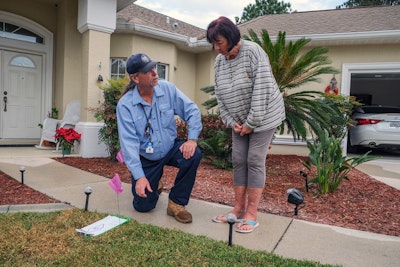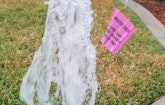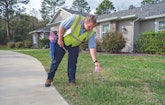
Citrus County Water Conservation Manager Debra Burden and her team (from left) water conservation specialists Ed Bugbee, Tom McConnell, Reg West and Florida-Friendly Landscaping Program coordinator Steve Davis. The group is standing in the Florida-Friendly learning landscape garden that is used as a teaching tool to show people what plants are beneficial to their environment. (Photography by Stephen J. Shaner)
Interested in Education/Training?
Get Education/Training articles, news and videos right in your inbox! Sign up now.
Education/Training + Get AlertsDebra Burden is the idea person in the Water Conservation section of the Department of Water Resources in Citrus County, Florida, and the impact of her ideas and of the work of her water conservation team is real and measurable.
Tens of millions of gallons of water in the county is being saved every year through their efforts, thereby forestalling the time when water availability in the West-Central Florida coastal county will become a critical issue.
“We know we have enough water to meet our current demand and future demands for 20 years,” Burden says. “At the end of that 20-year period, we will need to look at alternative water supplies.”
Twenty years. That’s practically around the corner. The era of critical water usage in the county will arrive even sooner if Burden’s water conservation programs fail.
Persuading owners
Ironically, Citrus County has an abundance of water in and around it. No question about that. The Gulf of Mexico is to the west of the county, of course, but that’s saltwater. Inland, the county has 24 freshwater lakes, reputedly more than a hundred fishing spots including along two rivers, and hundreds of springs.
“We are surrounded by water,” Burden acknowledges. “We do have a lot of water here and that can be challenging to us. People say, ‘Conserve water? You have plenty of water.’”
The rest of the story is that the county also has plenty of people. Between 1960 and 2020, the population has grown from 9,000 to 19,000 (1970) to 93,000 (1990) to about 160,000 today. Needless to say, the water supply has not grown proportionally.
The water necessary to meet the needs of all these people is pumped from the Floridan aquifer that underlies the state. The aquifer is nearer the surface in Citrus County and immediately surrounding counties on the upper Gulf side of the state, which is why so many springs freely bubble forth. Three of them are so-called first-magnitude springs, meaning that each one discharges at least 100 cubic feet of water per second.
This is the water-rich environment in which Burden and her staff labor to persuade property owners and commercial interests to moderate their water usage. It is not always an easy sale. While there is general support from a public aware of the precariousness of the longer-term water situation, not everyone buys into conservation.
“We receive a great deal of public support and positive feedback for our education efforts and programming,” says Burden. “There’s one in my email inbox right now. But we do, of course, also receive negative comments. You know, why are we regulating water use when there is a bottled water company in the county with a water permit?”
The conservation manager says she responds with both personal and professional perspective. “I often reply that I don’t throw trash out the window just because some others do. Conserving water is the right thing to do. We do have a large number of people who are concerned about our springs. The public education that we do connects water use to the health of our springs. It shows how what we do on our own property can impact the springs.”
In the classroom
Burden is a Florida native who moved to Citrus County more than two decades ago and began working with the county, including in parks and recreation. In 2011, Citrus County was put on official notice by state and federal officials that its water management regime was failing to meet required conservation goals. County leaders responded by creating a water conservation manager position and Burden jumped at the chance to fill it.
“The job description was written for me. It has a lot of marketing and customer relations, and my degree is in public relations.” She heads a team of six people including a Florida-Friendly Landscaping coordinator and several water conservation specialists. Her responsibilities range from homeowner education to enforcement of one-day-a-week water restrictions.
Much of the work falls under the heading of education, though Burden doesn’t call herself an educator. “I think of myself as a program designer of education. I personally am not the one carrying out education in the field or in the classroom. I think I am more of a behind-the-curtains person.”
One of her education ideas involves elementary-age students and toilets. As part of Fix-A-Leak Week, the children in seven schools go home and check to see if family toilets are running. In the sixth annual leak-check in 2021, more than a hundred toilets were examined by the kids, who identified leaks that, if corrected, would save more than 3,000 gallons of water each day.
“Yes, that was my idea,” Burden admits. “That was a fun one. We are blessed to have teachers of students in third through fifth grade who want to participate. The teachers say they have the funniest conversations with the kids about their toilet checks. We know if we can teach our children about conservation, as they grow up, they will teach their parents.”
Burden credits water conservation efforts in other parts of the district for helping her. “The southern region of the district has had water conservation programs for 20 or 30 years. We have benefited from them. We pick up all the successful programs that we know have saved water.”
Improving irrigation
Irrigation counseling is where the conservation effort is most beneficial in terms of water volume preserved, according to Burden. “It is our big water saver and I’m most excited about it.”
The Gulf side of Florida is a famously warm region of the country, so year-round irrigation of lawns and landscape plants is common. On the other hand, the county averaged 60 inches of rain per year over the last decade, so it is not an arid region. Yet rain or no rain, property owners like to see their irrigation nozzles pivoting and spraying just to, you know, be sure the grass isn’t hurting.
The conservation team is trying to change such thinking and to modify some bad habits. Partnering with Southwest Florida Water Management District and Withlacoochee Regional Water Supply Authority, the county five years ago initiated an irrigation check-up program. Focusing on high water-users, one facet of the program begins with installation of a WaterSense irrigation controller on a property owner’s system.
WaterSense is a label attached to fixtures developed by commercial firms that meet the EPA’s water efficiency and performance standards. After the county installs a labeled irrigation controller, it follows up with training by the conservation staff on how to use the device. A full irrigation system inspection is given, with tips on how to improve various functions.
After each property owner is taught how to examine a system to ensure it is functioning properly, the person is asked to regularly perform such inspections, at least quarterly. The Water Resources Department then tracks water usage at the property for 12 months, comparing the results to the previous 12 months.
What is the department finding? Water savings. “On average, participants in the program are consuming 25 to 30% less water than before,” Burden says. The program mostly has focused on residential properties to date, with about 120 irrigation systems each year fitted with the WaterSense controllers and inspected. For the new year, the team is gearing up to focus on commercial irrigation systems.
“We found some of our customers struggled to make seasonal adjustments to the controller, overwatering at certain times of the year. A WaterSense controller can overcome that, turning off the irrigation after rain or reducing the amount of irrigating water being run through the system. Smart technology is the way of the future.”
She adds that conservation team members still go out to make sure property owners aren’t watering the sidewalk and otherwise uselessly spraying water. “People who set up an irrigation system and forget about it are a huge barrier to water conservation.” A corollary county program sends specialists out to properties for a free walk-through of water systems inside and outside a house and informs homeowners how to use water more efficiently.
Making headway
The various initiatives have garnered Citrus County Utilities three Partner of the Year awards from the EPA as well as three consecutive WaterSense Sustained Excellence Awards. These formally recognize that the county’s various public education and active intervention activities are accomplishing significantly more than a drop in the bucket.
In fact, Burden says, “We are saving an estimated 70, 80, 90 million gallons of water each year. That’s equivalent to easily serving one of our service areas for an entire month. When we talk about the 20-year time frame until we’ll need alternative water sources, we factor in all these savings. If we took them away, we would get to the end of our water supply much sooner.”
Still, Citrus County Utilities can’t rest on its conservationist laurels. It has a full-time pipeline leak detection crew and has contracted with a satellite leak-finding company to ferret out leakage in its water lines. It also is closely monitoring the condition of its pipelines, which average about 30 years in the ground. The county also sends treated water from its treatment plant to a golf course for irrigation use and is upgrading the plant to increase the amount of reclaimed water it can distribute to other courses.
From all of this, the conservation manager concludes that the county is making headway in its efforts to protect the aquifer and use water resources efficiently.
“I really do think we are making progress. I look at our customers’ water use. The number of them that are exceeding an ideal amount of usage is becoming less and less each year even though the size of our customer base is growing each year. So, that’s a good sign.”









